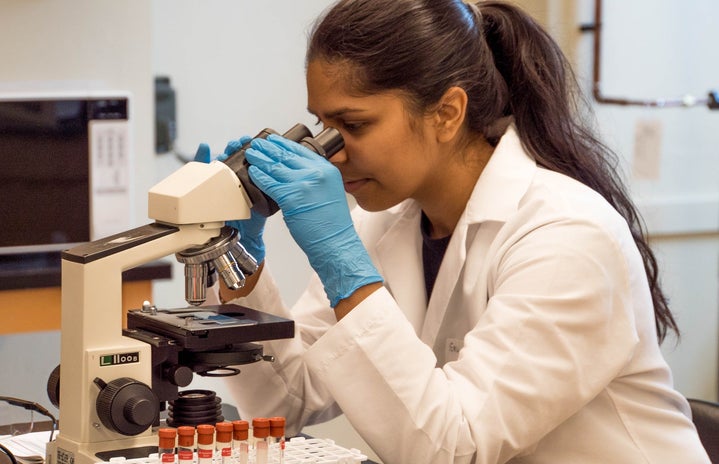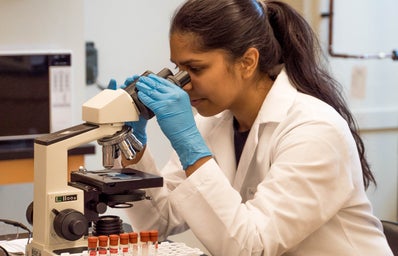In honor of Day of Girl, Her Campus Clark conducted an interview with four members of Clark Women in STEM to discover what the holiday means to them.
Clark Women in STEM is a club geared toward everyone to “explore the struggles women may face in the STEM field.”
They host events with speakers, discussions, and outreach within the community.
To find out more about the club, Clark Women in STEM can be contacted at clarkswomeninstem@gmail.com.
1. What is your position in Clark’s Women in STEM?
Regan Conrad: Co-President. Sam and I also co-founded the club in our freshman year.
Sam Hughson: Co-President
Jess Strzempko: Treasurer
Victoria White: Secretary
2. Why do you think clubs like this are important?
Conrad: It’s important for minority members in the STEM community to have a place to go to and find others like them, to be able to talk to others like them and find people to relate to them.
Hughson: Having a female community to be able to discuss similar problems we face is a great resource for not feeling hopeless and alone.
Strzempko: It’s important to provide a space for people with similar experiences of underrepresentation in STEM fields to discuss and organize. Our club aims to create that welcoming space but also encourage people to stand up against the injustices they encounter.
White: Represents a minority group in the STEM fields
3. Why is it important for women to be in the STEM field?
Conrad: Having representation in every field is important! The more perspectives and opinions that you can get from a diverse group of people, the more likely you are to find a solution to your problem. This is especially true to STEM fields, where we’re working on huge, complex problems like curing diseases or working on climate change.
Hughson: Because diverse communities are better communities. We deserve a seat at the table.
Strzempko: I’ve heard it said a million time over in all different circumstances, but seeing someone like you achieving the things you want is incredibly empowering. When we improve diversity in leadership positions in STEM fields, we are saying to a younger generation of students that yes, you can do this, and no, your demographics shouldn’t define the limits of your success.
White: To show that women are capable of doing hard sciences just like men.
4. What motivated you to be in the STEM field?
Conrad: I’ve always loved science and math, and after realizing that I could go into research in the STEM field and change people’s lives for the better, I was hooked.
Hughson: I grew up with my dad working at the Microsoft main campus in WA and saw amazing things, especially on bring your kids to work day, and senior year I took a CS class and fell in love.
Strzempko: In high school, I had a couple of amazing teachers in physics and calculus who didn’t just teach me the material but showed me why I should care and how the topics we were learning explained the world around me. This paired with my love of the outdoors led me to study environmental science – what I see as the perfect marriage of social and hard sciences.
White: Always enjoyed learning about science and how life works.
5. Is there any advice you’d give a younger you about going into the STEM field?
Conrad: Never give up or doubt yourself. Your ideas and experiences are as valid as anyone else’s, so don’t put yourself down or doubt what you can contribute.
Hughson: Don’t be sorry. You will doubt yourself but you belong. Go for what you want not for what you think the world wants from you.
Strzempko: It’s ok to ask questions and not know everything right away. That’s the whole point of learning. As long as you work hard and are passionate about the process, the results will come.
White: I would tell myself that its HARD and you have to put in a lot of work, but once you understand the material, you feel super smart.
6. How can you motivate more women to try the STEM field?
Conrad: Having more female mentors for students at a younger age and marketing toys that encourage engineering, logic, and problem solving to both girls and boys. Also, bringing attention to women who have contributed to the STEM field through their discoveries and hard work.
Hughson: Representation matters. Having women in the upper level of STEM companies and fields for the world to see will inspire the next generation.
Strzempko: By encouraging more young women to be curious about scientific and mathematic topics through exploration and real world applications. Additionally, removing the barriers, stigma, and discouragement that come with making mistakes or not knowing an answer.
White: I would ask them a question about nature/life and ask it they want to know how it works. If they do, I’ll tell them to try taking a science class that explains more about the answer.
7. Is there anything specific you think needs to change to aid more women in joining the STEM field?
Conrad: We need more female mentors for all students, in the form of both teachers and executives in companies. We need to push to close the gender wage gap.
Hughson: Universities need to hire more women to be in the STEM departments. And also just not teaching at a young age that boys play with blocks and girls play with dolls. The gender separation can really harm the choice to go to into STEM.
Strzempko: I think the next step is getting more women of all races and backgrounds into positions of power, whether that be as professors at universities or bosses in the corporate field. My hope is for these women to lift up those below them who need a hand.
White: That STEM is impossibly hard and only men understand what’s going on. FALSE.
8. What social, cultural, economic, and emotional undercurrents are at play with women being in the STEM field?
Conrad: Socially, I think we’re taught from a young age that math and science are for the boys as they engineer with Legos and we’re handed dolls. We’re taught that being pretty and quiet is best, but in STEM anyone and everyone should speak their mind. Economically, women are paid less for the same job as men and have fewer opportunities to advance their career.
Strzempko: As we said by the other eboard members, the social normas that are inadvertently passed along to children have become ingrained in our way of thinking. This continues on later in life when women are faced with the harsh reality that they will be paid less for equal amounts of work. Women must combat these assumptions and feelings of being an imposter all to reach their goals.
White: Social: women are shy and nerdy and have no social skills. Cultural: women are less intelligent than men and need more assistance with figuring out problems. Economic: women make way less than men for doing the same research. Emotional: women getting frustrated that their voices and work is underrepresented.
9. What do you want to do professionally one day?
Conrad: My goal is to go into bioinformatics and computational biology. I’d love to conduct research on diseases or medicine that I could later point to and say, I made a difference in making someone’s life better with that!
Hughson: I want to work on accessible computing and make technology be accessible for all and be able to aid those who need it.
Strzempko: Not sure about my future goals just yet, but I’ve been dipping my toes into research science lately to see if this career path interests me. Regardless, I want to be working in an environmental field.
White: I want to work in the health field, doctor or PA.
10. Did you have any female mentors that have specifically helped you fulfill your goals of getting there?
Conrad: Our club’s advisor, Prof. Dresch, taught a computational biology course that I took my freshman year. Her enthusiasm for the subject, along with the fact that I had never seen a younger woman teaching a math-heavy course, made me realize that if she could do it, maybe I could too!
Hughson: My boss at the ADA Developers academe helped me start off my journey into the tech industry.
Strzempko: Somehow I’ve managed to have only female mentors on my career path so far. These have included my advisor, Karen Frey, and my internship mentor from this past summer, Ruth Haas-Castro. It’s hard to overstate how important it is to have role models that understand your worldview and your struggle!
11. Is there anything else I may have missed that you’d like to add?
Conrad: I also think it’s important o note that our club encourages both men and women to join! While we focus on women’s issues in the STEM field, we know we can’t do this without the support of everyone, and the fact is that men play a pivotal role in deciding how we stand. The more people who stand with us, the better!
Strzempko: Just a reminder – our events and our club welcomes all genders, all majors, and all backgrounds. The changes we want to see aren’t going to happen alone.
White: Science is for everyone and no one should be daunted by the STEM field.


